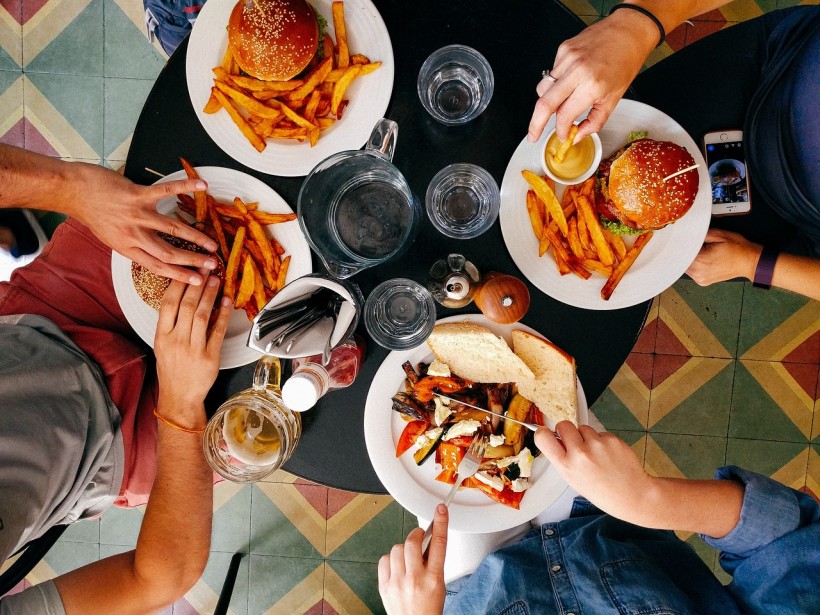Social cues play a role in influencing eating habits, supported by decades of research indicating increased consumption in the company of others. Researchers have explored how companions can influence food choices, raising inquiries about leveraging these influences for adopting healthier eating habits, reducing fats and sugar, and potentially achieving weight loss.

Friends and Food: How Dining Together Influences Appetite
Impact of Group Size on Meal Duration and Indulgence: Insights into Social Eating Dynamics
Careful examination across various eateries has unveiled an intriguing pattern: larger groups tend to prolong their meals. Interestingly, when meal times are fixed, the size of the group ceases to influence the quantity consumed.
A pivotal 2006 experiment involving 132 participants, given 12 or 36 minutes to eat cookies and pizza, revealed consistent consumption regardless of party size-strong evidence supporting the connection between extended meal durations and larger social eating portions.
The idea that dining with friends may lead to lingering and indulgence, like reaching for an extra slice of cheesecake, is quite plausible. Anticipating a group meal not only encourages longer meals but also prompts individuals to order more food individually.
An Italian restaurant observation showed a correlation between larger dining parties and increased orders of pastas and desserts for each diner. This phenomenon has been encapsulated in C Peter Herman's "feast hypothesis," suggesting that indulgence is intrinsic to social meals, allowing collective enjoyment without the guilt of overindulgence.
Moreover, the desire to indulge appears resilient, extending to scenarios where the dining companion isn't physically present. A Japanese study found that individuals eating popcorn alone before a mirror reported greater enjoyment compared to those facing an image of a wall.
This prompts contemplation on the psychological impact of mirrors in restaurants, where their prevalence might contribute to enhancing the pleasure of shared dining experiences.
READ ALSO: Why Is There Always Room for Dessert Even After a Hearty Meal? Unveiling Satiety's Sweet Temptation
Navigating Social Dynamics for Healthier Choices and Conscious Control
Occasionally, social dynamics restrain the inclination to overindulge. The need for social conformity often regulates behavior, leading people to adhere to social norms. This might involve following cues from others, a phenomenon known as social modeling.
Numerous instances exemplify this behavior. Studies indicate that obese children eat less in groups, and overweight individuals adjust their food consumption based on the company. For instance, women consume fewer calories when dining with men, but more when in women-only groups. Across the US, diners order more desserts when served by heavier waitstaff.
In the UK, diners increased vegetable intake after seeing posters emphasizing prevalent vegetable consumption. The presence of scattered sweet wrappers can similarly influence individuals to consume more chocolates.
A 2014 study highlighted the moderate impact of such behavior on food intake, with females reacting more strongly to males. This aligns with the concept that we pick up cues on appropriate behavior and adjust our eating habits accordingly.
While few studies explore the evolutionary reasons behind eating based on social context, it's speculated that conforming to social norms could have aided food-sharing among hunter-gatherer ancestors. Emulating others may also have helped children develop preferences for safe and nutritious foods.
As readily available snacks contribute to current eating norms, people often mirror the habits of their close social circles, caring less about overeating if everyone gains weight together. Recognizing these social influences on eating habits is crucial for conscious control over meals and healthier choices, without necessitating the abandonment of friends with different eating habits.
RELATED ARTICLE: Food Psychology: Color of Dishware Can Trick the Brain Into How a Food Would Taste
Check out more news and information on Psychology in Science Times.



![Earth's Quasi-Moon Kamo‘oalewa Could Originate From Lunar Surface Not Asteroid Belt [Study]](https://1721181113.rsc.cdn77.org/data/thumbs/full/53275/89/56/50/40/earths-quasi-moon-kamo-oalewa-could-originate-from-lunar-surface-not-asteroid-belt-study.png)










